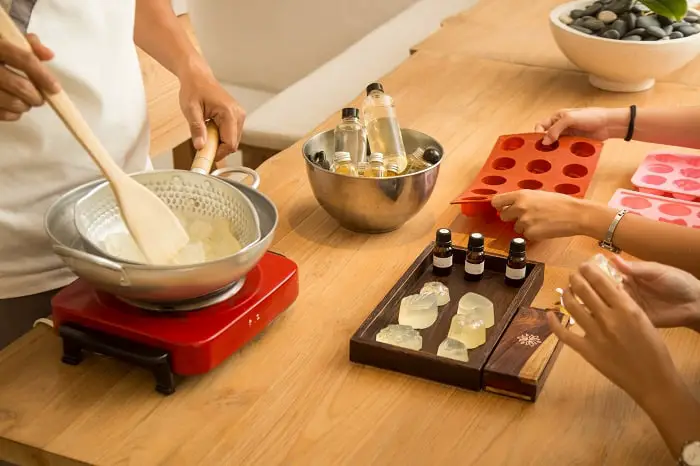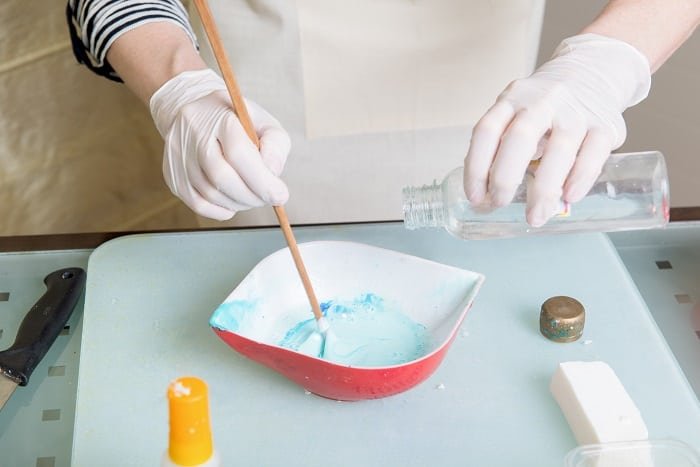Last Updated on May 28, 2022
Most people opt to make homemade soap because they have ultimate control over the ingredients. Also, most soap owners enjoy the craft if soap making, because it allows them to come up with a natural product that smells good.
Essentials oils can be used to add a natural scent to handmade soap. If it is important to you that you keep your soap as natural as possible, then essential oils are definitely the way to go. In fact, most people are now learning how to make essential oils at home.
Although essential oils are obtained from a natural raw material of plant origin, they can cause skin irritations if not safely used in the product. Usually, every essential oil has a recommended usage rate that should be followed, depending on what you intend to make.
Almost every new soap maker wants to know how much essential oils to add to homemade soap. I am no exception, and this stirred me to do extensive research on the matter.
How Much Essential Oil Should You Use?
Well, this is a tricky question, and probably the most common question with regards to soap making. The amount of essential oil used in the soap recipe greatly contributes to the scent retention.
There is a need to use the right amount of essential oils as too much can cause skin irritation or photosensitivity. I wouldn’t suggest using scents like cinnamon and clove in your recipe as they are strong and can cause skin sensitivity.
When making soap with essential oils, there is a need for a fragrance calculator. But why use a fragrance calculator? Well, a fragrance calculator will help you to determine how much oil you will use for every pound of soap.
With a fragrance calculator, you just need to choose the kind of product you intend to make, the essential oil you will use, and how much you want to make. The calculator will then tell you how much essential oil you can add to your product.
Basically, different essential oils have varying fragrance strengths. For this reason, the fragrance calculator takes into account the potential for skin sensitivity and phototoxicity and lets you know the maximum threshold. The calculator uses the usage rates as recommended by the International Fragrance Association (IFRA).
The fragrance usage rate for the majority of cosmetics products is between 0.5% to 5% of the whole formula. Wash-off products like cold process soap, the essential oil usage rate is usually in the middle range of up to 4%. This mid-range usage is the total amount of the essential oils in the soap recipe by weight.
It is obvious that oils that are heavier and thick weigh more than thin and light essential oils. For the melt and pour process, 0.25 ounces of essential oil would be ideal for a pound of soap.
You will notice that each essential oil has its guidelines and challenges. For this reason, some essential oils may have a lower usage rate than others. Again, the recommended usage rate will depend on the strength of the scent. For a strong scent like Almond Fragrance oil, you can add 16 ounces of the oil to one pound of cold process soap.
How to Calculate Blends of Several Essential Oils
Contrary to popular belief, it is possible to create a blend of essential oils during soap making in order to evoke a wide range of scents. However, most people find it difficult to safely use several essential oils in one soap recipe.
When making my blend of essential oils, I usually ensure that the base notes, middles notes, and top notes are in the appropriate percentage. The main idea is to ensure that 10 percent of the blend is base notes, 60 percent is middles notes, and 30 percent is top notes. Notice that using certain base oils like cocoa and shea butter can affect the final fragrance of the cold process soap.
If you want to create a blend of essential oils, make sure that the combined usage rate does not exceed 0.8 ounce to one ounce per pound of oil. You can opt to combine an essential oil with a low usage rate together with oils that have high usage rates. For example, I love to create a blend of clove bud essential oil (0.08 oz) together with patchouli essential oil (0.5oz), to form a total usage rate of 0.58 ounces.
Most importantly, it is recommendable to do extensive research on the essential oils you intend to use before blending them together. This will give you an idea of their performance and unique challenges in soap making.
For instance, clove leaf essential oil is known to be a skin sensitizer and can cause problems when used in leave-on products like lotions. But there is no cause for worry when it is used in cold process soap as it will be washed off.
How to Add Essential Oils to Homemade Soap
We recommend adding your essential oil to your soap after it hits trace. The soap will achieve a light to medium trace after you add lye-water to the soaping oil and you start to mix. When you achieve a light trace, it means that the soap has a consistency like that of running honey. A medium trace is the consistency of custard, while a thick trace is stiff enough to hold its form.
Alternatively, you can choose to add your preferred essential oils before the soap achieve trace. However, some people say that the scents don’t make it through the process.
Conclusion
Understanding the different usage rates for essential oils is paramount for both novice and experienced soap makers. Adding fragrance to soap is a form of art, and we suggest starting small until you achieve your desired results.
Besides finding the right essential oil, you also need to learn how much essential oils to add to homemade soap. This way, you can safely make scented soap at home without worrying about skin allergies.
Do you have any questions or concerns regarding how much essential oil you need for your homemade soap? Don’t hesitate to comment below and we will make sure to answer swiftly.

Lacey is an environmental enthusiast and passionate advocate for living green and sustainable. She believes that everyone can make a difference, no matter how small. Lacey is dedicated to reducing her own carbon footprint and educating others on the importance of living greener. She is an advocate for green energy and sustainable practices. She is an active member of her local community, volunteering with local conservation efforts, and taking part in sustainability initiatives. Lacey is a firm believer that the only way to ensure a sustainable future is to work together and make small, but important changes.


